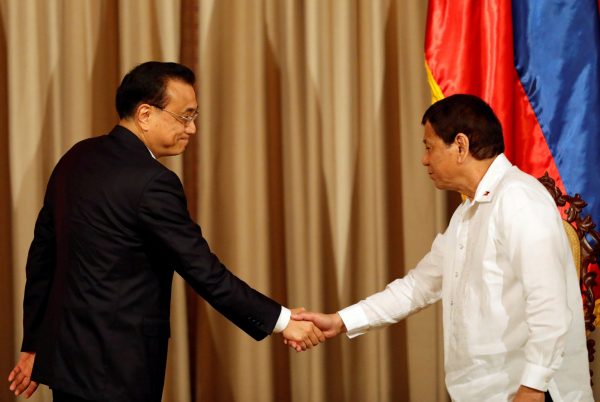Since the early 1990s, China’s outward FDI has increased from a few million to US$2.5 trillion in 2015 — largely due to overcapacity and falling rates of profitability in China. Since new Chinese companies continue to form and Chinese citizens need somewhere to invest given low yields at home, territorial issues at low-to-moderate levels do little to temper foreign capital inflows.
An alternative conceptual explanation is more convincing in the case of the Philippines — the eruption of competition within a country’s ‘elites’ as well as mobilisation of citizens in the host state can lead to the relative stagnation of FDI.
From 2001–10, Gloria Macapagal Arroyo became the first Philippine president to recognise China’s inevitable role in the global economy, shelving her countries’ territorial claims in the South China Sea to strengthen bilateral ties. The strong political relationship between the Philippines and China culminated in 65 bilateral agreements and more than 20 large Chinese investments in the Philippine economy.
But by the end of Arroyo’s term, the Philippines became one of the lowest recipients of Chinese FDI in Southeast Asia. Why?
The first reason was inter-elite competition and social mobilisation from her administration’s opponents. For example, the Chinese Department of Transportation and Communication and the Zhongxing Semiconductor Corporation (ZTE) agreed on an investment contract worth US$329.5 million to upgrade the Philippines’ telecommunication infrastructure. But pressure from opposition parties and numerous social movements forced Arroyo to cancel the project.
Intra-elite competition within the administration’s own allies also played a key role. The Jinchuan Non-Ferrous Metal Corporation in the Nonoc Mines and the ZTE in the Diwalwal mine both appeared to be promising multi-billion dollar deals. The Arroyo government also signed 18 land lease agreements with Chinese agribusiness companies. But these deals came undone as congressmen and local elites within Arroyo’s own party resisted China’s mineral and agriculture investments due to the redistributive implications on their rent-seeking activities.
Finally, Arroyo’s inability to temper her own elites’ rent-seeking activities led to the failure of Chinese FDI. The Industrial and Commercial Bank of China (ICBC) almost reached an agreement with Arroyo’s administration to establish operations in the Philippines. But the Philippine representative in the negotiations wanted equity in some of the planned branches, which ICBC declined to entertain. While Arroyo could have reprimanded her representative, she would have lost a key political ally, which might have led to her impeachment.
To put this in perspective, there were over 20 deals negotiated, agreed and somewhat implemented during Arroyo’s term, but only one large project passed. This project was the 2007 consortium created by the State Grid Corporation of China (SGCC) with Calaca High Power Corporation and the Monte Oro Grid Resources Corporation. But the SGCC was only successful because its partner companies were owned by Enrique Razon and then subsequently purchased by Henry Sy, two of the most powerful economic elites in the Philippines.
Elite competition and social mobilisation has also shaped the fate of Chinese investments during Benigno Aquino III’s (2010–16) and Rodrigo Duterte’s administrations.
At the start of his term, Aquino did not substantially deviate from Arroyo’s foreign policy position. Indeed, the Aquino government discussed the possibility of China investing in more than 10 projects. But elite competition and the victory of a particular faction within Aquino’s cabinet led to the Philippines’ defensive behaviour towards China.
When the South China Sea issue erupted in 2012, these plans were eventually shelved by both states. China further responded by limiting Philippine agricultural exports, banning Chinese tourist companies from operating in the Philippines and unilaterally imposing a fishing ban on the contested area in the South China Sea.
Fast forward to 2017, and the Philippines and China agreed on 24 major investments during Duterte’s state visit to China, signed memoranda of agreement worth US$15 billion with companies and agreeing on US$9 billion in loans.
While the current Chinese and Philippine governments seem to be continuing what the Arroyo government started, Duterte has a significant advantage. During Arroyo’s administration, elite competition and social mobilisation hindered the arrival of powerful players in the Philippine economy. In comparison, the majority of the elites and the population appear to support Duterte, providing his administration with the power to implement and complete Chinese investments. Duterte has also inherited Aquino’s strengthened institutions and economic gains which have effectively muted opposition voices.
As a result, Chinese FDI is back in the strategic sectors of transportation, energy and infrastructure. In October 2017, China and the Philippines agreed on a US$9 billion loan for Philippine National Railway’s Bicol Express, which will connect the Southern Luzon provinces to Metro Manila by rail. China has also been targeted to build the Mindanao Railway Project. In the energy sector, Alfredo Yao — a Philippine economic elite — has decided to partner with Energy China to construct a US$2 billion coal-fired power plant in Luzon. China companies are currently exploring potential ventures in ports, telecommunications, chemicals, tourism, and acquaculture.
In sum, foreign policy need not always be the cause of FDI flows. In the case of Chinese investments in the Philippines, rent-seeking elites and a mobilised populace can have a far greater effect.
Alvin Camba is a doctoral candidate in the Department of Sociology at John Hopkins University. The commentary is drawn from a research project comprising more than 60 interviews with Philippine government officials, politicians, and Chinese investors as well as an original statistical dataset on elite competition and social mobilisation in the Philippines.


A very compelling analysis. I teach political science at an American SLAC and I have always thought that international relations can only explain a part of the phenomena. Do you think your framework is applicable elsewhere?